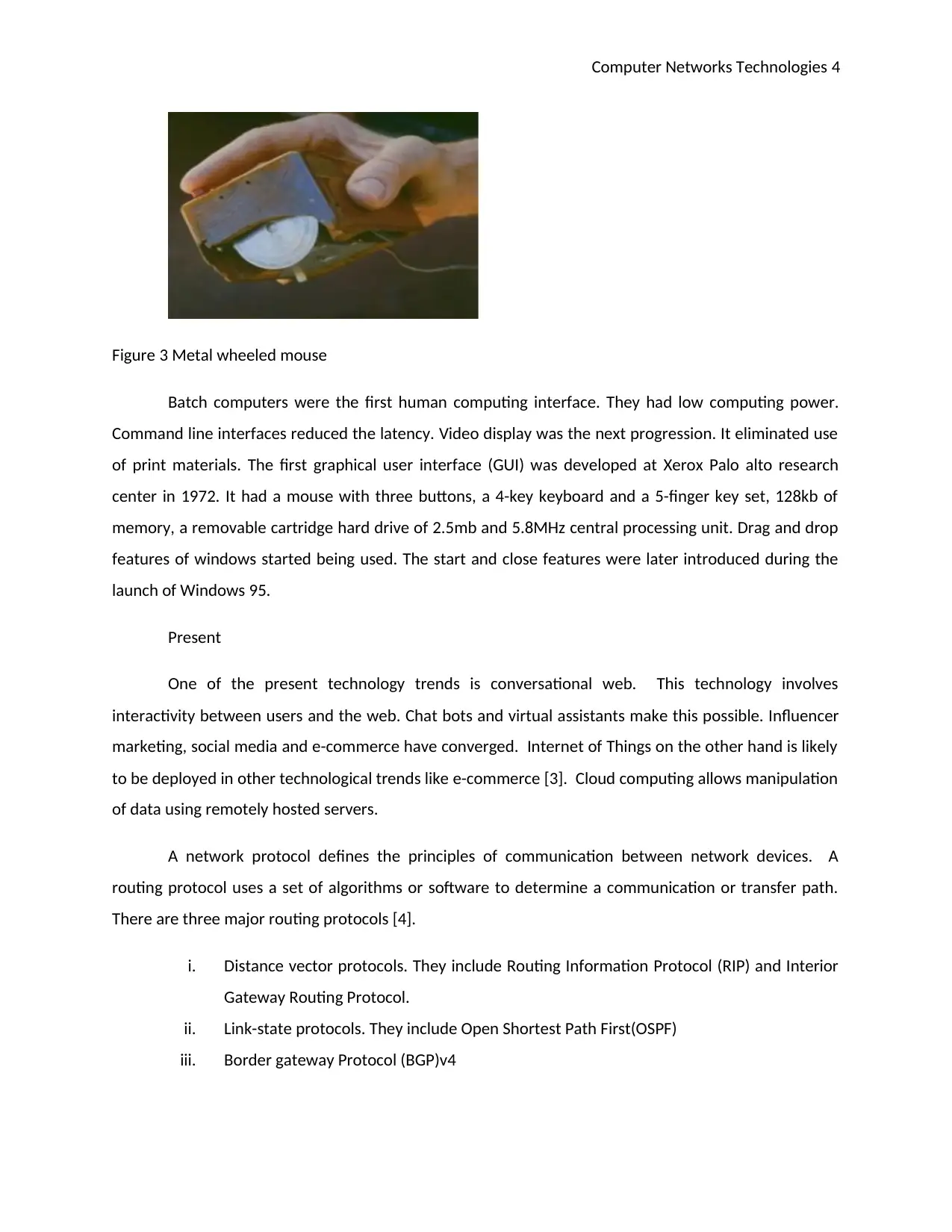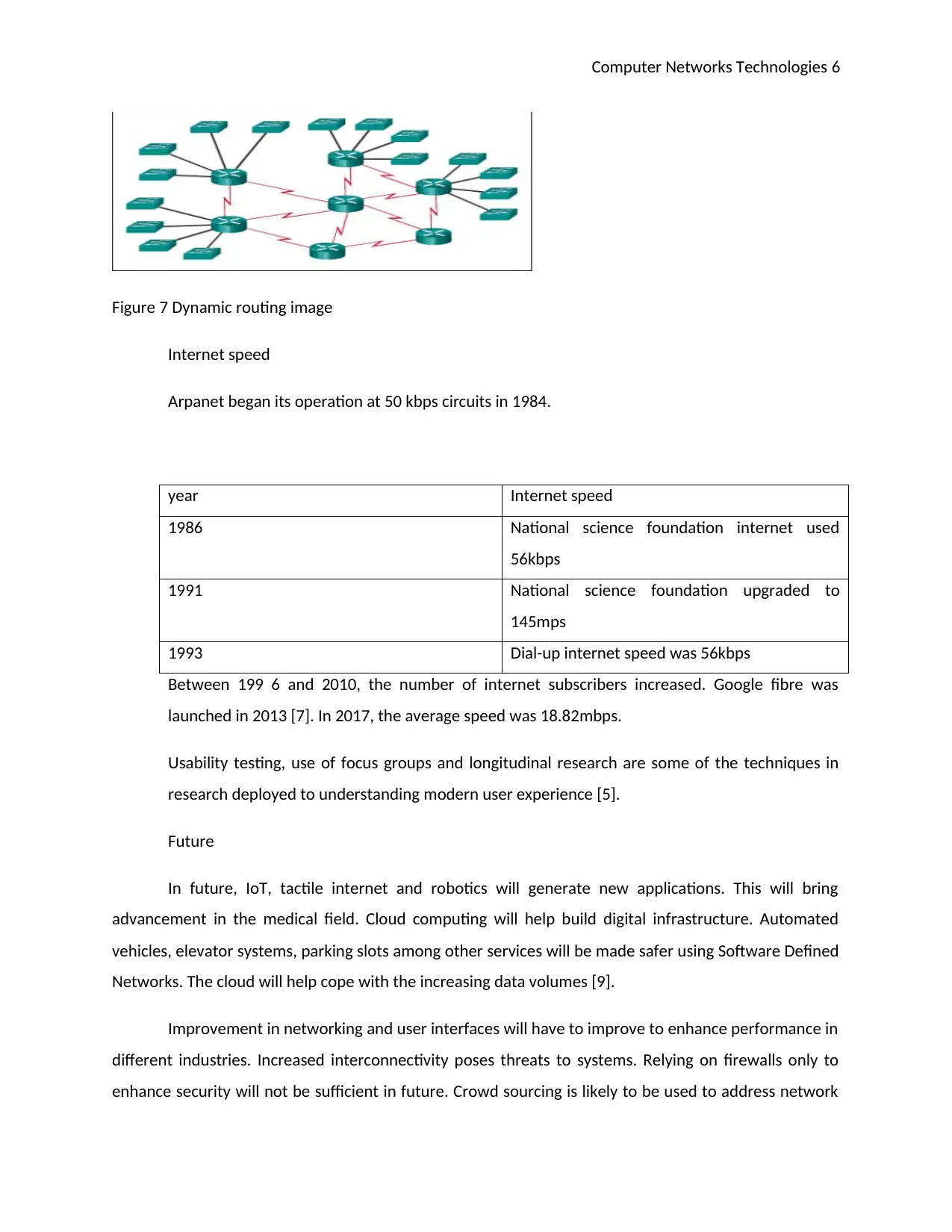Computer Networks Technologies: History, Present and Future
VerifiedAdded on 2023/06/12
|9
|1657
|342
AI Summary
This report discusses the history, present and future of computer networks. The design aspects including the different network models are well illustrated. The technologies used in networking are explained. The main internet protocols, their advantages and disadvantages are discussed. Changes in internet speeds over time are also discussed.
Contribute Materials
Your contribution can guide someone’s learning journey. Share your
documents today.

Computer Networks Technologies 1
Author
Professor
University
City, State
Date
Author
Professor
University
City, State
Date
Secure Best Marks with AI Grader
Need help grading? Try our AI Grader for instant feedback on your assignments.

Computer Networks Technologies 2
The infrastructure of a network is influenced by the decisions made during network design and
implementation. The implementation methods of networking change with time because networking is a
dynamic technological development. This report discusses the history, present and future of computer
networks. The design aspects including the different network models are well illustrated. The
technologies used in networking are explained. The main internet protocols, their advantages and
disadvantages are discussed. Changes in internet speeds over time are also discussed.
History
A computer network is a system that allows communication of systems or workstations that are
interconnected. Computer networking started with ARPANET in the early 1970s. The ARPANET design
was based on packet switching for effective resource sharing. The design introduced protocol layering .
The design had three layers. The network layer included switch-to-switch and network access layers. In
function oriented protocol, file transfer and mail services were among the applications provided and the
host-to-host layer [1].
Another protocol layer had to be added to the hierarchy to accommodate the increasing
interconnectivity. This led to the invention of the Internet Protocol and the Transmission Control
Protocol (TCP/IP). Increased demand for interoperability led to the invention of the Open Systems
Interconnection (ISO). The TCP/IP protocol was adopted by UNIX operating systems. However, the OSI
architecture has become dominant because of its inability to satisfy the interoperability demands of
systems [1].
Feature OSI TCP/IP
layers It has seven layers. Application, presentation,
session, transport, network and data-link layers
It has four layers. Application,
transport, internet and network
access layer.
independency It is protocol independent It is protocol dependent
Protocol
replacement
Protocols can be replaced with changes in
technology
Protocols cannot be replaced
easily
Connectivity
services
The network layer provides connectionless and
connection oriented services
The network layer provides
connectionless services.
implementation It is a reference model on which networks are
built
It is an implementation of the
OSI model
The infrastructure of a network is influenced by the decisions made during network design and
implementation. The implementation methods of networking change with time because networking is a
dynamic technological development. This report discusses the history, present and future of computer
networks. The design aspects including the different network models are well illustrated. The
technologies used in networking are explained. The main internet protocols, their advantages and
disadvantages are discussed. Changes in internet speeds over time are also discussed.
History
A computer network is a system that allows communication of systems or workstations that are
interconnected. Computer networking started with ARPANET in the early 1970s. The ARPANET design
was based on packet switching for effective resource sharing. The design introduced protocol layering .
The design had three layers. The network layer included switch-to-switch and network access layers. In
function oriented protocol, file transfer and mail services were among the applications provided and the
host-to-host layer [1].
Another protocol layer had to be added to the hierarchy to accommodate the increasing
interconnectivity. This led to the invention of the Internet Protocol and the Transmission Control
Protocol (TCP/IP). Increased demand for interoperability led to the invention of the Open Systems
Interconnection (ISO). The TCP/IP protocol was adopted by UNIX operating systems. However, the OSI
architecture has become dominant because of its inability to satisfy the interoperability demands of
systems [1].
Feature OSI TCP/IP
layers It has seven layers. Application, presentation,
session, transport, network and data-link layers
It has four layers. Application,
transport, internet and network
access layer.
independency It is protocol independent It is protocol dependent
Protocol
replacement
Protocols can be replaced with changes in
technology
Protocols cannot be replaced
easily
Connectivity
services
The network layer provides connectionless and
connection oriented services
The network layer provides
connectionless services.
implementation It is a reference model on which networks are
built
It is an implementation of the
OSI model

Computer Networks Technologies 3
Packet delivery The transport layer guarantees packet delivery The layer does not guarantee
packet delivery
communication It is a communication gateway between a user
and the network
It is a communication protocol
that connects network hosts
Figure 1 Differences between OSI and TCP/IP
year technology
1995 windows
1996 – rise of the digital age Javasoft products and services
1998 Incorporation of google
2002 Microsoft.net
2004 facebook
2006- referred to as the mobility age Blueray disk
2007 Smart phones
2009 3D printers
2013 Digital clocks
2014 automation
Figure 2 Technological innovations
Douglas Engelbart invented the mouse in 1964. It had a shell made of wood, a circuit board and
two wheels made of metal. Later the “ball mouse” was invented. This mouse was used in the Xerox Alto.
The optical mouse was invented in 1980. The type writer was the first keyboard layout invented. The
fast typing speed of writers led to the invention of the QWERTY keyboard in order to slow them down
[2].
Packet delivery The transport layer guarantees packet delivery The layer does not guarantee
packet delivery
communication It is a communication gateway between a user
and the network
It is a communication protocol
that connects network hosts
Figure 1 Differences between OSI and TCP/IP
year technology
1995 windows
1996 – rise of the digital age Javasoft products and services
1998 Incorporation of google
2002 Microsoft.net
2004 facebook
2006- referred to as the mobility age Blueray disk
2007 Smart phones
2009 3D printers
2013 Digital clocks
2014 automation
Figure 2 Technological innovations
Douglas Engelbart invented the mouse in 1964. It had a shell made of wood, a circuit board and
two wheels made of metal. Later the “ball mouse” was invented. This mouse was used in the Xerox Alto.
The optical mouse was invented in 1980. The type writer was the first keyboard layout invented. The
fast typing speed of writers led to the invention of the QWERTY keyboard in order to slow them down
[2].

Computer Networks Technologies 4
Figure 3 Metal wheeled mouse
Batch computers were the first human computing interface. They had low computing power.
Command line interfaces reduced the latency. Video display was the next progression. It eliminated use
of print materials. The first graphical user interface (GUI) was developed at Xerox Palo alto research
center in 1972. It had a mouse with three buttons, a 4-key keyboard and a 5-finger key set, 128kb of
memory, a removable cartridge hard drive of 2.5mb and 5.8MHz central processing unit. Drag and drop
features of windows started being used. The start and close features were later introduced during the
launch of Windows 95.
Present
One of the present technology trends is conversational web. This technology involves
interactivity between users and the web. Chat bots and virtual assistants make this possible. Influencer
marketing, social media and e-commerce have converged. Internet of Things on the other hand is likely
to be deployed in other technological trends like e-commerce [3]. Cloud computing allows manipulation
of data using remotely hosted servers.
A network protocol defines the principles of communication between network devices. A
routing protocol uses a set of algorithms or software to determine a communication or transfer path.
There are three major routing protocols [4].
i. Distance vector protocols. They include Routing Information Protocol (RIP) and Interior
Gateway Routing Protocol.
ii. Link-state protocols. They include Open Shortest Path First(OSPF)
iii. Border gateway Protocol (BGP)v4
Figure 3 Metal wheeled mouse
Batch computers were the first human computing interface. They had low computing power.
Command line interfaces reduced the latency. Video display was the next progression. It eliminated use
of print materials. The first graphical user interface (GUI) was developed at Xerox Palo alto research
center in 1972. It had a mouse with three buttons, a 4-key keyboard and a 5-finger key set, 128kb of
memory, a removable cartridge hard drive of 2.5mb and 5.8MHz central processing unit. Drag and drop
features of windows started being used. The start and close features were later introduced during the
launch of Windows 95.
Present
One of the present technology trends is conversational web. This technology involves
interactivity between users and the web. Chat bots and virtual assistants make this possible. Influencer
marketing, social media and e-commerce have converged. Internet of Things on the other hand is likely
to be deployed in other technological trends like e-commerce [3]. Cloud computing allows manipulation
of data using remotely hosted servers.
A network protocol defines the principles of communication between network devices. A
routing protocol uses a set of algorithms or software to determine a communication or transfer path.
There are three major routing protocols [4].
i. Distance vector protocols. They include Routing Information Protocol (RIP) and Interior
Gateway Routing Protocol.
ii. Link-state protocols. They include Open Shortest Path First(OSPF)
iii. Border gateway Protocol (BGP)v4
Secure Best Marks with AI Grader
Need help grading? Try our AI Grader for instant feedback on your assignments.

Computer Networks Technologies 5
Static routing is a manual selection of a communication path in a network by an administrator. It
is used in situations where network parameters are constant. For example if the route is single
and the devices involved are few.
advantages disadvantages
Easily implemented in a small network Managing static configurations on large
networks is time consuming
Routing algorithms are not required Failure in routing calls for manual correction
It is predictable because the route is similar It cannot be used in large networks
Lack of advertisements makes it secure
Figure 4 Static routing
Figure 5 Static routing image
In dynamic routing, the routing table is periodically changed.
advantages disadvantages
It can be used in all topologies It is less secure because of the multiple route
updates.
Rerouting traffic is possible Initial implementation can be complex
It does not depend on network size Additional resources like CPU and memory are
required
Figure 6 Dynamic routing
Static routing is a manual selection of a communication path in a network by an administrator. It
is used in situations where network parameters are constant. For example if the route is single
and the devices involved are few.
advantages disadvantages
Easily implemented in a small network Managing static configurations on large
networks is time consuming
Routing algorithms are not required Failure in routing calls for manual correction
It is predictable because the route is similar It cannot be used in large networks
Lack of advertisements makes it secure
Figure 4 Static routing
Figure 5 Static routing image
In dynamic routing, the routing table is periodically changed.
advantages disadvantages
It can be used in all topologies It is less secure because of the multiple route
updates.
Rerouting traffic is possible Initial implementation can be complex
It does not depend on network size Additional resources like CPU and memory are
required
Figure 6 Dynamic routing

Computer Networks Technologies 6
Figure 7 Dynamic routing image
Internet speed
Arpanet began its operation at 50 kbps circuits in 1984.
year Internet speed
1986 National science foundation internet used
56kbps
1991 National science foundation upgraded to
145mps
1993 Dial-up internet speed was 56kbps
Between 199 6 and 2010, the number of internet subscribers increased. Google fibre was
launched in 2013 [7]. In 2017, the average speed was 18.82mbps.
Usability testing, use of focus groups and longitudinal research are some of the techniques in
research deployed to understanding modern user experience [5].
Future
In future, IoT, tactile internet and robotics will generate new applications. This will bring
advancement in the medical field. Cloud computing will help build digital infrastructure. Automated
vehicles, elevator systems, parking slots among other services will be made safer using Software Defined
Networks. The cloud will help cope with the increasing data volumes [9].
Improvement in networking and user interfaces will have to improve to enhance performance in
different industries. Increased interconnectivity poses threats to systems. Relying on firewalls only to
enhance security will not be sufficient in future. Crowd sourcing is likely to be used to address network
Figure 7 Dynamic routing image
Internet speed
Arpanet began its operation at 50 kbps circuits in 1984.
year Internet speed
1986 National science foundation internet used
56kbps
1991 National science foundation upgraded to
145mps
1993 Dial-up internet speed was 56kbps
Between 199 6 and 2010, the number of internet subscribers increased. Google fibre was
launched in 2013 [7]. In 2017, the average speed was 18.82mbps.
Usability testing, use of focus groups and longitudinal research are some of the techniques in
research deployed to understanding modern user experience [5].
Future
In future, IoT, tactile internet and robotics will generate new applications. This will bring
advancement in the medical field. Cloud computing will help build digital infrastructure. Automated
vehicles, elevator systems, parking slots among other services will be made safer using Software Defined
Networks. The cloud will help cope with the increasing data volumes [9].
Improvement in networking and user interfaces will have to improve to enhance performance in
different industries. Increased interconnectivity poses threats to systems. Relying on firewalls only to
enhance security will not be sufficient in future. Crowd sourcing is likely to be used to address network

Computer Networks Technologies 7
security. Artificial intelligence will be highly dependable for network security with the help of the cloud.
5G networks on the other hand is a wireless technology that aims at increasing speed and network
responsiveness. The wireless technology will also incorporate IoT [8].
Conclusion
Computer networks have evolved since the mid 90s. Low processing speeds and slow internet
connections are some characteristics of the past computer networks. The increase in interconnectivity
led to invention of network protocols to guide communication between devices. The need to have more
secure and effective networking led to technological innovations among which are internet of things,
cloud computing, artificial intelligence and the wireless 5G.These technologies have simplified human
activities in different industries . It cannot be concluded that the networking field has achieved its
objectives. The technologies continue to evolve. In future the milestones of these technologies will be
looked back at.
security. Artificial intelligence will be highly dependable for network security with the help of the cloud.
5G networks on the other hand is a wireless technology that aims at increasing speed and network
responsiveness. The wireless technology will also incorporate IoT [8].
Conclusion
Computer networks have evolved since the mid 90s. Low processing speeds and slow internet
connections are some characteristics of the past computer networks. The increase in interconnectivity
led to invention of network protocols to guide communication between devices. The need to have more
secure and effective networking led to technological innovations among which are internet of things,
cloud computing, artificial intelligence and the wireless 5G.These technologies have simplified human
activities in different industries . It cannot be concluded that the networking field has achieved its
objectives. The technologies continue to evolve. In future the milestones of these technologies will be
looked back at.
Paraphrase This Document
Need a fresh take? Get an instant paraphrase of this document with our AI Paraphraser

Computer Networks Technologies 8
References
[1]C. Sunshine, Computer network architectures and protocols. New York: Plenum Press, 1989.
[2]"typewriter history", my typewriter.com. [Online]. Available: http://mytypewriter.com/explorelearn/.
[Accessed: 18- Aug- 2018].
[3]"New Internet Technology Trends That Will Transform the Customer Experience", Forbes, 2017.
[Online]. Available: https://www.forbes.com/sites/forbesagencycouncil/2017/06/09/new-internet-
technology-trends-that-will-transform-the-customer-experience/#34770d3f3184. [Accessed: 18- Aug-
2018].
[4]"RoutingProtocol", Techopedia.[Online].Available:https://www.techopedia.com/definition/25927/
routing-protocol. [Accessed: 24- Aug- 2018].
[5]J. Jacko, "Human-Computer Interaction. New Trends: 13th International Conference", in Human-
Computer Interaction. New Trends: 13th International Conference, HCI International 2009, San
Diego, CA, USA, 2009.
[6]"User centered design", Interaction design foundation. [Online]. Available: https://www.interaction-
design.org/literature/topics/user-centered-design. [Accessed: 18- Aug- 2018].
[7]B. Patrick, "An Accelerated History of Internet Speed (Infographic)", Entrepreneur, 2013. [Online].
Available: https://www.entrepreneur.com/article/228489. [Accessed: 18- Aug- 2018].
[8]J. Tan, "Cloud Computing Is Crucial To The Future Of Our Societies", Forbes, 2018.
[9]A. Manzalini and R. Verdone, "5G Experimental Facilities in Europe", 2017.
References
[1]C. Sunshine, Computer network architectures and protocols. New York: Plenum Press, 1989.
[2]"typewriter history", my typewriter.com. [Online]. Available: http://mytypewriter.com/explorelearn/.
[Accessed: 18- Aug- 2018].
[3]"New Internet Technology Trends That Will Transform the Customer Experience", Forbes, 2017.
[Online]. Available: https://www.forbes.com/sites/forbesagencycouncil/2017/06/09/new-internet-
technology-trends-that-will-transform-the-customer-experience/#34770d3f3184. [Accessed: 18- Aug-
2018].
[4]"RoutingProtocol", Techopedia.[Online].Available:https://www.techopedia.com/definition/25927/
routing-protocol. [Accessed: 24- Aug- 2018].
[5]J. Jacko, "Human-Computer Interaction. New Trends: 13th International Conference", in Human-
Computer Interaction. New Trends: 13th International Conference, HCI International 2009, San
Diego, CA, USA, 2009.
[6]"User centered design", Interaction design foundation. [Online]. Available: https://www.interaction-
design.org/literature/topics/user-centered-design. [Accessed: 18- Aug- 2018].
[7]B. Patrick, "An Accelerated History of Internet Speed (Infographic)", Entrepreneur, 2013. [Online].
Available: https://www.entrepreneur.com/article/228489. [Accessed: 18- Aug- 2018].
[8]J. Tan, "Cloud Computing Is Crucial To The Future Of Our Societies", Forbes, 2018.
[9]A. Manzalini and R. Verdone, "5G Experimental Facilities in Europe", 2017.

Computer Networks Technologies 9
1 out of 9
Related Documents
Your All-in-One AI-Powered Toolkit for Academic Success.
+13062052269
info@desklib.com
Available 24*7 on WhatsApp / Email
![[object Object]](/_next/static/media/star-bottom.7253800d.svg)
Unlock your academic potential
© 2024 | Zucol Services PVT LTD | All rights reserved.




